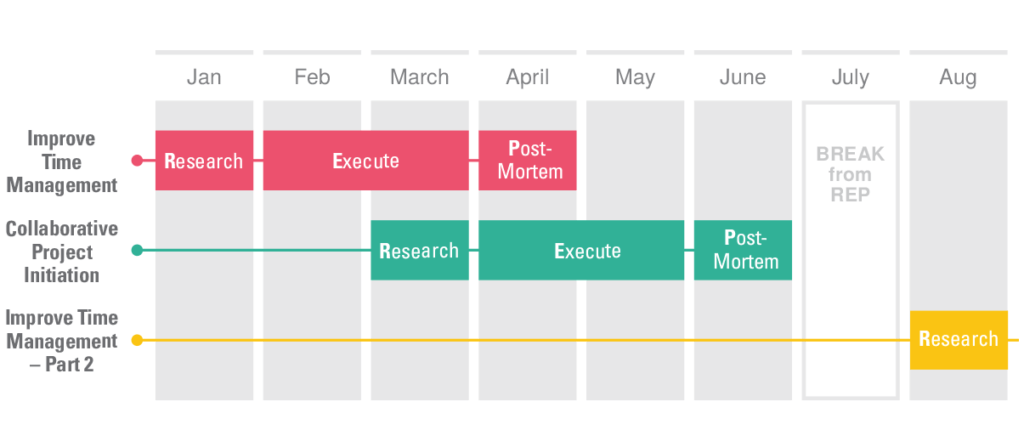Anyone can become a leader – it just takes practice, intent, and commitment. This applies to both project managers and team members; after all, leadership is a choice. We follow great leaders who motivate us to achieve more, not because of title or authority.
Develop your leadership skills with our free project handbook
Regardless of your position, you can practice leadership skills at any stage of a project.
I’ve put together four essential skills to help you get started on your leadership journey. Don’t forget to download your free copy of Collaborative Project Management: A Handbook for more tips and insights.
How to Improve Your Project Leadership Skills
1. Communication
From emails to IMs, meetings, presentations, impromptu chats, and vendor management – communication underlies all project activity. There are numerous ways to improve your communication skills, but a good place to start is with active listening.
In The Leadership Handbook: 26 Critical Lessons Every Leader Needs, John C. Maxwell wisely notes the best leaders are listeners. Listening leads to understanding and new insights, which improves your relationships with the team and colleagues.
Another element of effective communication is selecting the right format. When preparing a project communication plan, it’s easy to get tied up choosing the best tools and channels so remember to get back to basics.
Ryan Holmes, CEO of Hootsuite, recommends face-to-face interactions as much as possible. Not only does this help to move the project along faster, but it’s also an excellent way to link recent achievements to the objectives of the project and organizational strategy, an essential motivational strategy.
It’s also important to identify your own communication style – passive, aggressive, passive-aggressive, and assertive – and the communication preferences of your team so you can adjust your approach as needed.
Actions: Work on active listening, make more time to talk to your team face-to-face, and develop your own communication styles for different situations.
2. Challenge and Debate
Effective leaders such as Elon Musk and Sheryl Sandberg actively seek out conflicting opinions and debate to surface new ideas and approaches. Don’t be afraid to explore or offer differing opinions where appropriate. Likewise, take note of what people don’t talk about and find out why.
Such openness increases employee engagement and fosters psychological safety, a feeling that the team accepts risk-taking, feedback, and continual learning. This is key to team collaboration.
Depending on the project or topic, you can appoint a team member to the role of ‘devil’s advocate’ during planning and review sessions. This individual has sole responsibility for asking questions and challenging assumptions, helping the team to really stretch their thinking.
To encourage healthy and respectful debate, ask your team to try radical candor. Developed by Kim Scott, radical candor is a combination of ‘caring personally and challenging directly’. Scott developed the idea following some very honest feedback on her public speaking skills from Sheryl Sandberg.
The feedback was delivered honestly and with the goal of helping Scott become more successful, not as a personal criticism. Whether you are a project manager or team member, you need to speak up and give feedback when the plan goes awry.
Actions: Get comfortable with being uncomfortable! Ask for conflicting opinions and share honest feedback.
3. Problem Solving
According to futurist Bob Johansen, leaders require a new set of skills to deal with an increasingly complex, fast-paced world. Amongst these skills are ‘maker instinct’, the ability to build and grow new things, and ‘dilemma flipping’, a talent for turning problems into advantages and opportunities.
A leader who pursues and encourages non-traditional, creative solutions will build a strong reputation as someone who can ‘get things done’, no matter how confusing or difficult the task.
This skill has a natural relationship with challenge and debate; creating a culture of open discussion spurs innovation.
Action: Be open to new ideas, both within and outside of your industry.
4. Continual Learning
Continual learning has two aspects.
Firstly, make constant learning a daily practice.
- Get feedback from your colleagues on your strengths and weakness, and nurture both skillsets.
- Be curious about your business; become familiar with the organization’s strategy and look beyond your own role to understand how your company operates.
- Research industry trends, common practices and processes, challenges, and tools.
- If something goes well, understand why and how to repeat this success.
- Learn from leaders you admire and choose some of their lessons to practice.
Secondly, learn from every experience. Returning to ‘The Leadership Handbook’, Maxwell writes that experiences themselves are not as valuable as the knowledge and insights we can glean from each event – if we take time to understand and review. This examination can take place at both an individual and team level.
- Individual: At BrightWork, we advocate the ‘REP’ approach to personal change management, which stands for Research, Execute, and Post-Mortem. During the research phase, find a new skill or idea you wish to try. Execute this practice for a set period and use a post-mortem to reflect on your learnings. What worked well? What didn’t go well? How will you improve your approach?
- Team: At the end of each project, run a post-mortem with the team to gather lessons and insights for future projects.
Actions: Make learning part of your daily routine and set aside time to reflect on your experiences.
Next Steps: Where to Start?
So far, we’ve reviewed four key areas of project leadership and practical tips to develop these skills.
- Communication: Work on active listening, make more time to talk to your team face-to-face, and develop your on communication styles for different situations.
- Challenge and Debate: Get comfortable with being uncomfortable! Ask for conflicting opinions and share honest feedback.
- Problem-solving: Be open to new ideas, both within and outside of your industry.
- Cotinual Learning: Make learning part of your daily routine and set aside time to reflect on your experiences.
If you feel a bit overwhelmed – don’t worry! Developing leadership skills takes time and your repertoire will evolve as you move through your career.
If you are struggling to get started, try the above-mentioned REP process.
- Research: Pick a skill you wish to nurture and research how to do so. Use a REP journal to document these learnings and pick a few to try. Decide when and how you will start. Be realistic! Taking on too much at once without a clear plan will lead to frustration and disappointment.
- Execute: Implement these new learnings, taking note of your experiences.
- Post-Mortem: Schedule time to reflect on your experiences and what adjustments are needed.
Whilst you can complete more than one REP simultaneously, set aside enough time to complete each stage fully. Here is a sample 12-month schedule, covering three REP topics:

If this cycle is too long, opt for shorter, weekly REPs using this template:
- Monday: Do some research to identify one or two new practices to try in the coming week.
- Rest of week: Execute these activities and track your progress in a REP journal.
- Monday of the following week: Complete your post-mortem of the previous week’s activities and decide how to proceed during the coming week.
- Repeat.
